#Trauma Responses: Fight Flight Freeze Fawn
Explore tagged Tumblr posts
Text
X-Files Scully Trauma Responses: Fight, Flight, Freeze, or Fawn?
Picking up from this post about Mulder, we have Scully's turn!
There are four main trauma responses: Fight, Flight, Freeze, and Fawn (taken from the book Complex CPTSD: From Surviving to Thriving by Pete Walker-- see Disclaimers section below for info.) In short: Fight Types respond to stress with physical intimidation or verbal bullying; Flight Types run as far as they can from danger (physically or metaphorically), fleeing or distracting their minds with obsessive-compulsive work; Freeze Types disassociate, seeing fight and flight as futile and becoming numb to life; and Fawn Types try to win favor from their oppressor, leaning co-dependently on others.
Scully's Primary Trauma Response Type
Flight Types



"A Flight response is triggered when a person responds to a perceived threat by fleeing; or, symbolically, by launching into hyperactivity. .... Extreme Flight types are like machines with a switch stuck in the 'on' position. They are obsessively and compulsively driven by the unconscious belief that perfection will make them safe and loveable. They rush to achieve. They rush as much in thought in action, compulsion."
Beyond the Sea explored the breadth of Scully's Flight Type Trauma Response: Scully tried to avoid the pain of her father's death by distracting herself with work before the funeral; but was forced to sit in her feelings of inadequacy and beg for reassurance of his fatherly pride from her mother. "Was he at all proud of me?" is the backbone of her type, just as it was in relation to her partnership with Mulder, her daughterly duties to Maggie, her sisterly duties to Bill, and her professional duties as a medical doctor, Academy instructor, and field agent. Furthermore, this episode laid the groundwork for the infamous hallway scene in Fight the Future. As Rob Bowman stated: "‘I need you, I need you.’ That’s a theme of the movie – Mulder needs Scully. And never before has he come to that understanding quite so strongly as he does in this story. So she’s running because she’s afraid that he’s going to talk her out of it, and so the best thing she can do is hit the elevator button and go, go, go."

Classic Flight Type, classic.
(An interesting note: As stated above, Scully's "machine" is stuck in the "on" position-- the exact opposite of Mulder's type, which is stuck in the "off" position. Scully's traumatic response is to bury herself in obsessive-compulsive disordered behavior to distract from the lack of control she has over her life--finding refuge in long-working hours or needlessly consuming chores-- after her father's death, Emily's death, Mulder's disappearance and death, her mother's death, her son's fake death, etc. While Scully seeks out tasks, people, and duties from life (a.k.a. whether that be her on-the-clock job or extra busywork on weekends and holidays), Mulder retreats from people during his traumatic responses, becoming reclusive and alienated, dungeonIng himself away from life in his basement or leather couch.)
But what if her primary trauma response isn't working fast enough to combat fear or danger? In this case, Scully will develop a secondary trauma response, the polar opposite of her dominant one:
Flight-Fawn Types

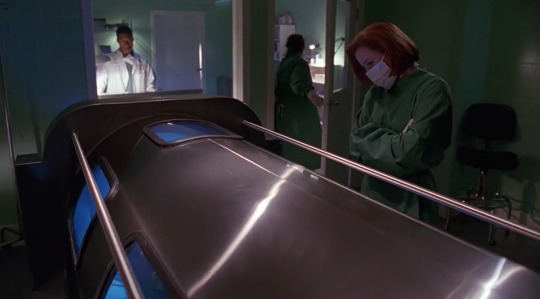

Flight-Fawn Types (also known as Super Nurses, ironically) turn the obsessive-compulsive workaholism of the Flight Type into the bend-over-backwards self-imposed slavery of the Fawn Type. As Pete Walker explains: "The Fawn-Flight Type is the most typically seen in the busy-holic parent, nurse, or administrative assistant who works from dawn until bedtime providing for the needs of the house, the hospital, or company. He" [she] "compulsively takes care of everyone else's needs with hardly a gesture towards his own. The Fawn-Flight is sometimes a misguided Mother Theresa-type who escapes the pain of her self-abandonment by seeing herself as the perfect, selfless caregiver. She further distances herself from her own pain by obsessively-compulsively rushing from one person in need to another. Some Fawn-Flight clients become OCD-like clean-aholics."
As we know, Scully fashions herself as Mulder's partner, primary caretaker, and right-hand Starbuck, while also acting as his translator, justifier, and report writer to the higher ups.
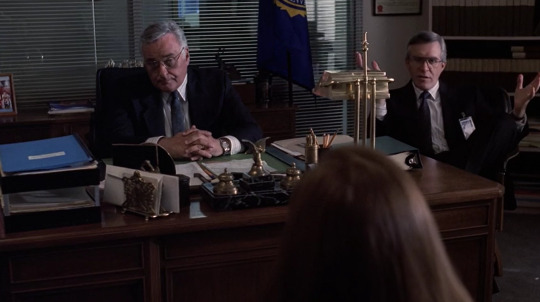
When Mulder messes up in all areas of his life, she flies in to patch him up and cover for him. This, of course, is fulfilling... but it's also distracting, purposefully so. Her Flight-Fawn Response also emerges its head whenever she tries to placate her brother Bill: cut off from Flight, she will utilize Fawn-- letting him ramble, pushing back only a little while pleading for understanding-- before ultimately volleying back to Flight whenever he gives her enough room to squeeze by and make her escape. Even on her last legs during the cancer arc, Scully still got swept up into verifying Mulder's quest against her previously expressed wishes--Flight-Fawn in full effect.
Why Scully Is Not Primarily Fight, Freeze, or Fawn
Fight Types

"A Fight response is triggered when a person suddenly responds aggressively to something threatening. ...Fight Types are unconsciously driven by the belief that power and control can create safety, assuage abandonment, and secure love...." Fight Types often become bullies or narcissists to their loved ones as well as their enemies if left unchecked. At their worst, they can become demanding, demeaning, and punishing because they equate strength as power exerted to weaken a threat. Fight is the first Trauma Response all humans develop; and if it's used effectively, Fight Responders stick to this "effective" method rather than trying out others (the second Flight, third Freeze, or fourth Fawn.) This translates to a bitter outlook on the world, always suspicioning the motives of others in cruel or judgmental ways. Severely traumatized Flight Types usually grew up in homes where they had to fight back against physical abuse or protect others from it. Dana Scully, while aggressive and cantankerous in the face of sniveling injustice, never uses her anger as a way to control or manipulate others; nor does she see other humans as self-interested threats.
Freeze Types

"A Freeze Response is triggered when a person, realizing resistance is futile, gives up, numbs out into dissociation, and/or collapses, as if accepting the inevitability of being hurt…. The Freeze Response, also known as the Camouflage Response, also triggers a survivor into hiding, isolating, and avoiding human contact. The Freeze Type can be so frozen in the retreat mode that is seems as if their "Starter” button is stuck in the “off” position. While all 4 F Types commonly suffer from social anxiety as well, Freeze Types typically take a great deal more refuge in solitude." These Types have learned from a young age that fighting back will only get you punished and that fleeing will only get you reprimanded; so, they collapse in on themselves instead. Dana Scully wields her independent agency freely and often, so this is definitely not her primary Type.
Fawn Types

"Fawn response is triggered when a person responds to threat by trying to be pleasing or helpful in order to appease and forestall an attacker.... Fawn Types seek safety by merging with the wishes, needs, and demands of others. They act as if they believe that the price of admission to any relationship is the forfeiture of all their needs, rights, preferences, and boundaries. The disenfranchisement of the Fawn Type begins in childhood... learns early that a modicum of safety and attachment can be gained by becoming the helpful and compliant servant of... exploitive parents." (As an aside, this type is formed from having at least one narcissistic parent who beat wore down the first natural human response-- Fight-- the second response-- Flight-- and the third response-- Freeze-- until all that is left is Fawn.) Dana Scully has never kowtowed or cheaply sold her self-respect to appease to others; and has only ever dipped into the Fawn Response as a capitulation or bargaining tool, hence why it is her secondary and not primary response.
Thank you for reading~
Enjoy!
**Disclaimers: Most of the information was obtained from Complex PTSD: From Surviving to Thriving by Pete Walker, a private counselor and lecturer for thirty-five years. As a victim of CPTSD himself, he made a study of its victims and helped craft a system for CPTSD recoverees to understand themselves and progressively heal. (Highly recommend his book-- excellent.)
#txf#xf meta#x-files#xfiles#meta#the x files#Scully#Trauma Responses#Trauma Responses: Fight Flight Freeze Fawn#CPTSD#analysis#Complex PTSD: From Surviving to Thriving#Pete Walker
32 notes
·
View notes
Text
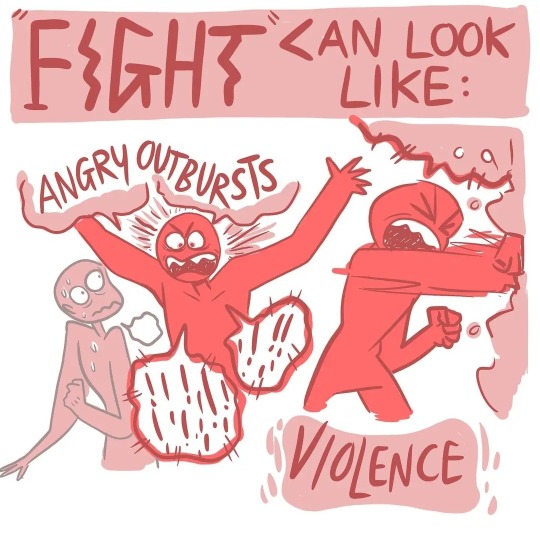
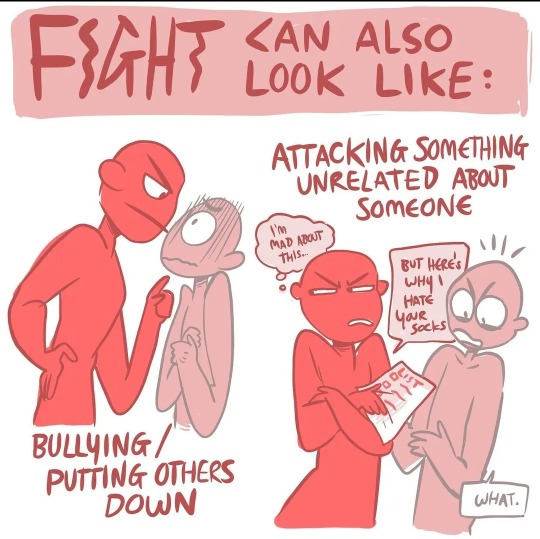

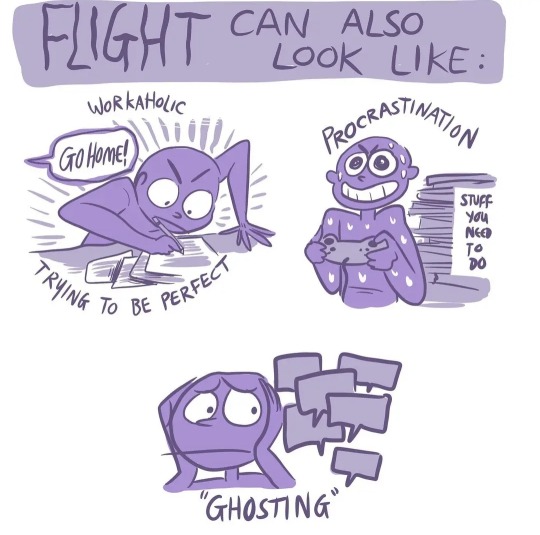
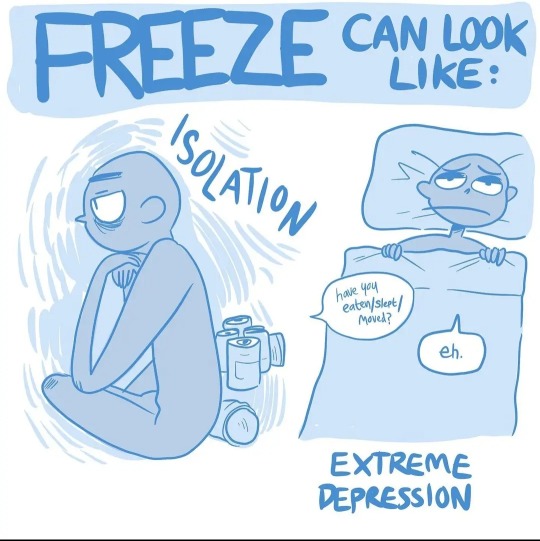

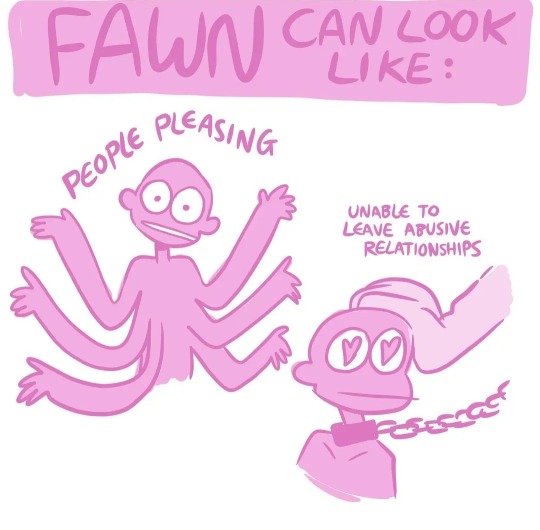
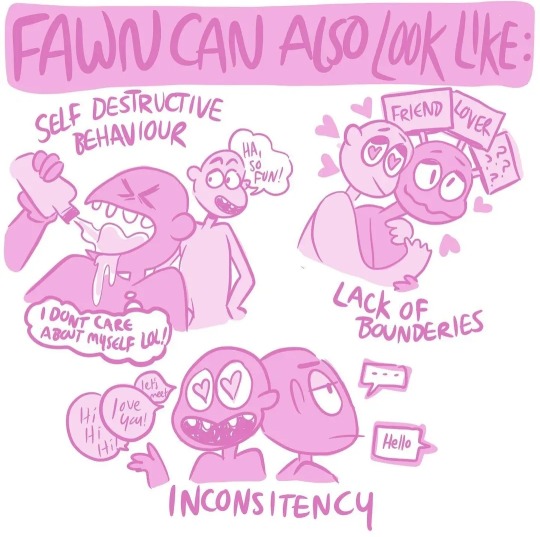
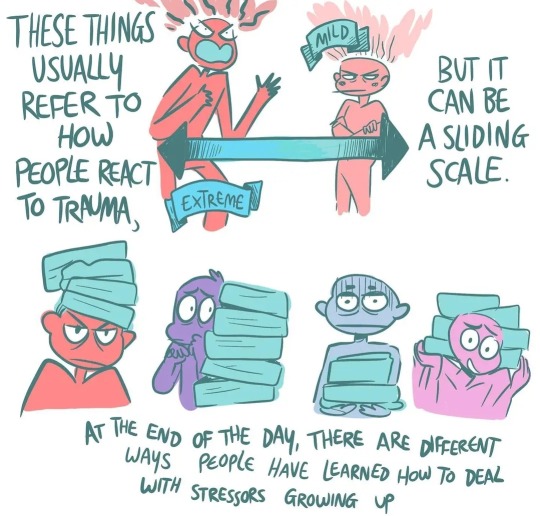

Art by Sarah Burgess
2K notes
·
View notes
Text
being around abusers:
high alert: you never know when the abuse is coming
hyper-focusing on the abuser's mood, you're only allowed to feel relief if the abuser seems to be in a good mood, distracted, or focused on somebody else
constant vigilance because they might decide to focus on you any second and you need to be ready
unable to focus on your tasks because you're tense and waiting to see if they'll want something from you, want to do something to you, or start to verbally abuse, provoke, insult, taunt, criticize or humiliate you
always aware of the physical distance between you and how much it would take them to cross it; reaction of panic if they turn your direction or show intent of approaching
quickly forced to think of an escape plan or a fight plan if they do keep approaching you because it is already an intimidation and likely to escalate in violence
anxiety if you're prompted to speak; you are not allowed to say anything positive about yourself or it will be challenged and mocked, you are usually asked to volounteer information and you will be attacked if you refuse. But if you do give info, it will be used against you.
constant effort needs to be put in controlling the amount of rage, or alternatively, helplessness you feel in their presence. You are not allowed to show any symptoms of it, or symptoms of panic
desperate use of logic and rationality in the face of senseless and cruelty of the abuse; you're trying to explain why the abuser should not say and do horrid and cruel things to you, and why you don't deserve it, only for them to do it worse and insist that they're 'saying the truth' or 'listing the imaginary reasons you do deserve it (you are not a person to them)'
attempts to defend yourself from the abuse or exploding and attacking back, only to immediately be accused of abuse and cruelty and 'lack of self control' while the abuser is not even affected by your attempts
the abuser getting anyone in the vicinity to side with them and to participate/enable the abuse, making you feel like your entire environment is hostile and dangerous, and like you are not a person to anyone
All of these can feel normal when you're used to living like that, or if you've grown up in this environment. Having to constantly defend and prove yourself and to have be hyper-focused on those around you and anxiously anticipate their every move, can feel like a normal experience if you haven't experienced any other home environment. This is not normal. If this is how you live, you are living in abuse. None of this should be inflicted at you.
#experiencing abuse#i thought all of this was just normal family environment#psychological abuse#development of cptsd#traumatic environment#child abuse#emotional abuse#fight flight fawn freeze response#long term abuse#long term trauma#abusive parents#abusive partners#living in fear#living in stasis of expecting abuse
369 notes
·
View notes
Note
I know eros is purposely making themselves look so soft but holy crap does it work on me. I want to hug them and treat them very kindly. Yeah I know you’re a little crazy but look at that cute little dress :)
they do like hugs! very very touch starved beast... they're generally niceys however the risk is, of course, that they've abandoned any sense of identity. which unfortunately includes a moral code, since having a sense of something being "wrong" might make them question if the pain He's putting them through is immoral... and you can't have that! they got into this situation by not being enough for Him, at least in their eyes, so the lack of personal morals is a survival tactic to be as obedient as possible {to hopefully make the pain stop}
so be very grateful that whole's goals are generally quite peaceful, and thus eros isn't usually violent, because they would maim at a moment's notice if that was asked of them ^-^
#fawn responses aren't always sweet and gentle! sometimes it's doing what's asked of you even if it hurts you or others#they're all kind of those trauma responses in a way since they're representative of soul's responses to the loop#nous is freeze eros is fawn and thymos is fight/flight but primarily flight#and fawn is seen as the nice sweet one but it can be just as destructive as the others#eros would do ANYTHING out of desperate devotion. they'd destroy themselves and everyone around them to please whole#thankfully whole is a Normal Guy and does not particularly enjoy murder. so you're safe#cccc#chonnys charming chaos compendium#chonny jash#cj soul#cccc soul#tridential tirade#captive audience#soul fragments
11 notes
·
View notes
Text
I need less of the Fawn Response and more of the Fuck You Response.
#slowly learning to do both :)#*cleans entire house bc he's mad at me* *flips him off*#trauma#neurodivergent#adhd#myposts#mentalhealth#mental health#mental health matters#fawn response#fight or flight#fight flight freeze fawn
10 notes
·
View notes
Text
What Survival Looks Like at Home
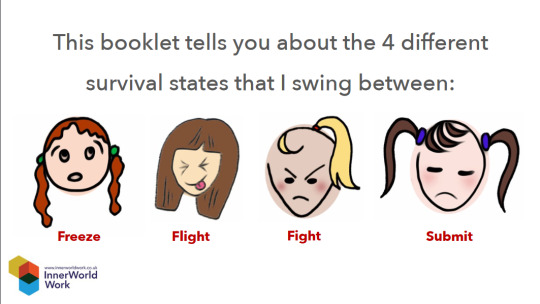




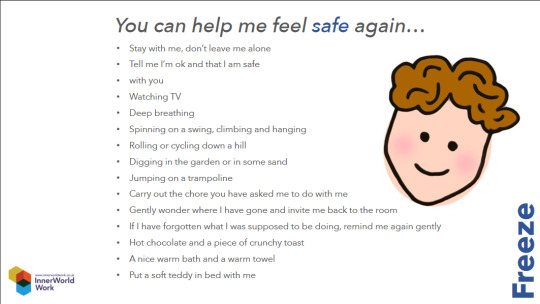
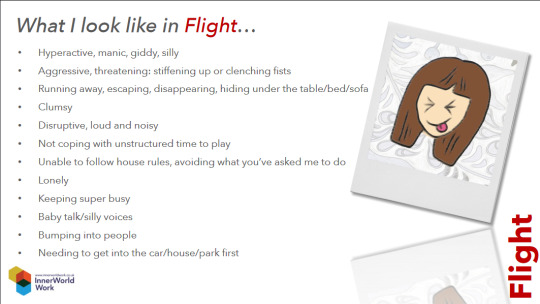

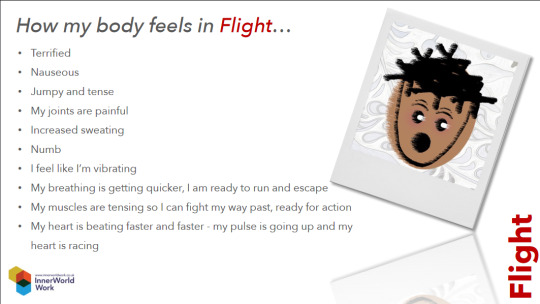
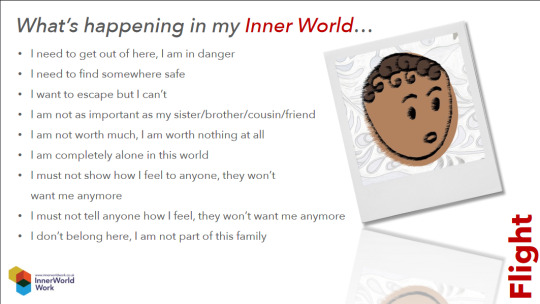



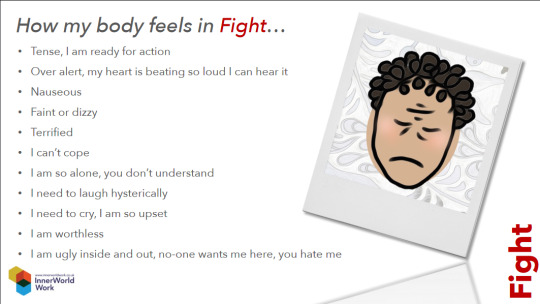





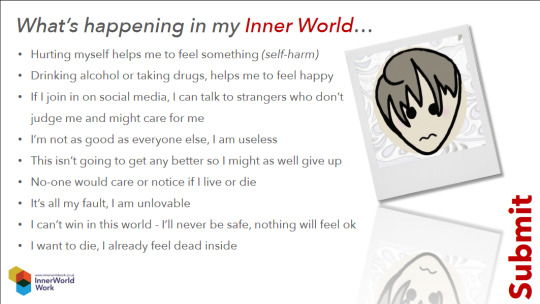

From 'What Survival Looks Like at Home' by Helen Townsend, from Beacon House & Inner World Work (PDF)
Quick cheat sheet:

Noticing Freeze
Bored, not interested
Confused, forgetful
Distracted, not listening
Clumsy
Talking about something else
Not moving to where you’ve asked
Scanning the room
Wide eyed, pupils might dilate
Daydreaming, staring into space
Grounding Freeze
Stay with me, don’t leave me
Tell me I’m ok & that I am safe
Watching TV
Deep breathing
Spinning on a swing
Climbing & hanging
Rolling or cycling down a hill
Digging in mud or sand
Jumping on a trampoline
Do my chores with me
Gently wonder where I have gone & invite me back to you
If I have forgotten what I was supposed to be doing, remind me again gently
Hot chocolate & toast
A warm bath & a warm towel
A soft teddy for bedtime
Noticing Flight
Hyperactive, manic, silly
Aggressive, threatening: stiffening up, clenching fists
Running away, escaping, disappearing, hiding under the table/bed/sofa
Clumsy
Disruptive, loud & noisy
Can’t cope with free play
Can’t follow house rules
Not doing what you’ve asked
Lonely
Keeping super busy
Baby talk/silly voices
Bumping into people
Needing to get into the car/house/park first
Grounding Flight
Keep me close by
Find me again happily or patiently
Deep breathing
Give me a familiar & easy chore
Crunchy foods – carrot sticks, a biscuit, a rice cake or crisps
Tell me that I am safe with you
Hanging from monkey bars
Talk through what you think I am finding tricky using a kind voice
Heavy blankets
Create a safe space where I can hide away I when I need to
Tug of war
Cup of warm milk or hot chocolate
Hot water bottle & a soft teddy
Recognize I sometimes find 'normal' family life threatening
Accept that if I feel threatened, I feel in real danger.
If you send me to do something & I forget, just patiently ask again
Noticing Fight
Hot and bothered
Argumentative, angry and aggressive
Controlling, demanding and inflexible
Lie or blaming
Unable to concentrate on one thing
Unable to follow the house rules
Confrontational
Disrespectful
Disregarding of others, pushing away friends/family members
Shouting, loud and noisy
Immature
Grounding Fight
Tell me you love me even when my I push you away
Don’t punish me for being cross; reward me with your kindness and love for getting calm again
Keep me safe from hurting myself
Match my energy
Deep breathing
Chewy foods
Support me socially
Hanging, swinging and climbing
Warm bath with lots of bubbles
Warm milk or a hot chocolate
Hot water bottle
A super soft teddy and/or blanket
Give me a task that makes me feel important
Connect with me and show me empathy before exploring the consequences of my behavior
Create somewhere safe to go to so I can calm down
Make things predictable. Tell me about changes before they happen, especially if strangers are coming to the house or I’m going somewhere new
Accept I might not know why I behaved in that way & I might not remember what happened
Listen and acknowledge how I feel, even if you see it differently, it will help me feel listened to
Noticing Submit
Unhappy, low mood
Alone or withdrawn
Fidgety but not disruptive, anxious
Never questioning or asking questions
Never drawing unnecessary attention
Yes or no answers - doing just enough to avoid being noticed, unable to think
Quiet & passive, compliant
Grounding Submit
See me, listen to me
Give me small repetitive things to do
Weighted blanket
Building with Lego or Play-doh
Tell me I am safe
Deep breathing
Swinging
Let me spend quiet time just with you
Understand that social media might symbolizes a comforting connection
Hot chocolate and a crunchy biscuit
Wrap me up in a soft blanket & watch TV
Understand that playing computer games, lets me be by myself somewhere safe
Recognize I am hurting inside & might need professional help
Know that I am easily bullied, look out for this, don’t expect me to tell you.
Notice I will say what I think you want me to say
Be aware that I am an easy target & can be coerced easily to keep the peace
Know I can't cope being the center of attention
Watch for me removing myself
Warm bath and a warm towel
Warm pyjamas
#meant for parents adopting traumatised kids. but i think it's good for anyone to recognise & soothe trauma responses in themselves/others#esp if you have child parts (in a DID way or a CPTSD/BPD/IFS etc way#described#described in alt text#long post#described in post#too many words for the alt text for that last one !#trauma#trauma responses#freeze#fight#flight#fawn#submit#dogpost
160 notes
·
View notes
Text
i’m not pathetic for fawning.
i shouldn’t get angry at myself for fawning.
it’s protected me from harm, it’s kept me safe.
fawning doesn’t make me pathetic. it is an indication that i am faced with a person who cannot regulate their emotions and who unduly directs their emotions at me. fawning is an indication that my body is working, working to keep me safe because it has learned from experience that this person’s behaviour will harm me.
i am not pathetic for trying to create safety for myself in a situation where the other person is emotionally volatile.
sometimes fawning makes me feel pathetic because i’m not expressing my true feelings or thoughts, because i feel like i can’t.
but i need to be compassionate with myself and interpret my fawning as something that has kept me safe, and it does not make me pathetic or feeble or spineless.
#cptsd healing#cptsd rant#cptsd vent#cptsd recovery#actually cptsd#healing#recovery#mantras#fawning#trauma response#fight flight or freeze
141 notes
·
View notes
Text
After watching the Netflix show Baby Reindeer, I found myself wrestling with difficult emotions. It helped me recognize that the behavior portrayed in the show is termed trauma bonding. This realization shed light on my own experiences, particularly what happened to me in 2022/2023 with the person who sexually assaulted me during a first date. It’s worth noting that months before I went out with him, he seemed to constantly appear wherever I went in my neighborhood, leading me to question whether it was all just a coincidence. Looking back and considering what I’ve since learned about him, it’s clear that there may have been ulterior motives behind his presence. I’ve come to realize that I don’t believe in coincidences, especially after everything that happened.
Reflecting on the unsettling dynamics of my past encounters with him, one particular incident stands out vividly in my memory. After one of my attempts to break off contact with him, he unexpectedly appeared at my door three months later while delivering food. He knew there are only two restaurants that I order from. I wasn’t aware that he had started working at one of them, and seeing him brought back waves of fear and discomfort. Despite my shock at his sudden appearance, I found myself frozen, unable to react, pretending as if everything was normal. He started crying and asked me why I had ignored and blocked him, further intensifying my feelings of confusion and discomfort. His sudden appearance caught me completely off guard.
I never reported him to the police because I wasn’t sure if it was seen as harassment and sexual assault and was too ashamed because I froze during the assault. When I got myself tested after the assault, I even lied to the doctor about the reason for the test. I also never shared this experience with anyone, and when I tried to talk about it with one of my friends, his response was unsupportive. It made me feel invalidated and silenced, preventing me from opening up about the full extent of what had really happened. My other friend was often too busy and had a tendency to label her friends based on whether or not they were ‘drama-free.’ Feeling unsure of how she would react, I hesitated to confide in her as well. I also considered telling my mom since she knew I went on a date with him when it happened, but I held back. Her tendency to become verbally aggressive and use such information against me left me feeling unable to share the truth with her. During one of the breathwork sessions I did in March, I allowed myself to cry and grieve about the assault and all that happened around it. I felt like I grieved a part of me that died in that awful experience. However, despite this emotional release, I still couldn’t bring myself to talk about it when we were sharing afterwards. Perhaps it was because of shame and fear of being misunderstood. Writing about it here feels somewhat as a relief, and hopefully, in a way, it helps others with similar experiences.
After struggling with the emotional aftermath of the assault and struggling to find support from those around me, I found myself resorting to smoking weed every night before bed as a means to numb my emotions and ignore the reality of what had happened. Understanding this dynamic has provided valuable insight into my own journey. Quitting weed 111 days ago was a significant step for me, and the serendipitous discovery of this timing today fills me with surprise and affirmation, strengthening my resolve to quit and my decision to write about it. It turned out to be one of the best decisions I’ve made, and perhaps I wouldn’t have come to this point of realization if I hadn’t. I can now work on forgiving myself and letting go of the self-blame, understanding that freezing during the assault was a common reaction to the overwhelming situation.
Whenever he contacted me, I acted like nothing had happened. It took me over a year and a lot of dark secrets of his that I had found out to break things off for good with him. Looking back, I realize in how much danger I actually was – his brother is arrested and is a first-degree murder suspect, and he himself is suffering from mental issues as a war veteran and has a case against him for rape and assault. When I froze during the assault, it may have saved my life. Things could have gotten so much worse had I resisted. As I continue on my journey of healing, I hold onto the hope that I will never have to cross paths with him or endure his presence again.
Reflecting on the complexities of trauma, upbringing, and conditioning, and their profound impact on our behavior, I am reminded of the interconnectedness of these past experiences. It’s through understanding and acknowledging these layers of past traumas and conditioning that we can begin to unravel their effects on our thoughts, emotions, and behaviors. By looking into the root causes and patterns that have shaped our responses, we gain insight into the ways in which past experiences continue to influence our present lives. This process forms the foundation for healing and growth, empowering us to navigate challenges with resilience and compassion for ourselves and others.
#personal#my writing#self reflection#healing#trauma#stalking#conditioning#shame#safety#breathwork#grief#people pleasing#coping mechanism#defense#fawn response#fight flight freeze fawn#freeze#behavior#emotions#psychology#baby reindeer#netflix#280424#0424#290424
10 notes
·
View notes
Text
I am about to go to bed, but real quick. I did this training at work today which included trauma responses to conflict. It got me thinking:
Fight: Asuka
Flight: Shinji
Freeze: Rei
Fawn: Kaworu (kind of?)
Is it possible that each of these four pilots represents a different trauma response? Maybe not intentionally, but it's kind of a cool - bah! What's the word? I'm too tired for this. I just wanted to throw this ideo out there before I forgot about it.
Poor Toji doesn't get one, but if I had to make one up for him it would be Flash, because dropping his drawers was his knee jerk reaction to Asuka slapping him.
#ask me things#my asks#answered asks#neon genesis evangelion#evangelion#shinji ikari#asuka langley soryu#rei ayanami#kaworu nagisa#toji suzuhara#trauma responses#conflict#fight flight freeze fawn
12 notes
·
View notes
Text
Hello!
I realized I'd gotten some research wrong here; so, I jumped back in and re-edited Mulder's Secondary Response section.
If you don't want to reread everything, I took a bit out for quick (if not thorough) reading~
Secondary Trauma Responses develop when circumstances are so extreme that a person's initial trauma response is not removing them from danger fast enough; and they then develop a second polar opposite response in the hopes that this will help. More often than not, it simply becomes a ping-pong whiplash between one extreme to the other. The four Hybrids are Fight-Fawn, Fight-Freeze, and Flight-Freeze. In Mulder's case, if he stays frozen for too long he will very quickly become very dead; thus, Mulder developed a secondary response: Flight.
Freeze-Flight (or Flight-Freeze-- potato, potatoh) Types

Below is an excerpt from Pete Walker, but it's so completely Mulder that I have nothing else to add:
"The Flight-Freeze Type is the least relational, most schizoid hybrid. He prefers the safety of "do it yourself" isolationism. The Fight-Fleeze Type avoids potential relationship traumatization with an obsessive-compulsive dissociative two-step. Step One is working to complete exhaustion. Step Two is collapsing into extreme vegging out and waiting until his energy reaccumulates enough to relaunch into Step One. The price for this time of no-longer-necessary safety is a severely narrowed existence."
(**Note for the below paragraph: the author is not talking about alpha/beta in the current, dilapidated vernacular. Think of it as an academic term describing more aggressive or assertive behavior as compared to more passive or dismissive behavior.)
"The Flight-Freeze cul-de-sac is more common among men, especially those traumatized for being vulnerable in childhood. This then drives them to seek safety in isolation, or "intimacy lite" relationships. Some non-alpha type male survivors combine their flight-freeze defenses to become stereotypical technology nerds. Telecommuting is, of course, their preferred modes.
Flight-Freeze Types are the computer addicts who focus on work long periods of time and then drift off dissociatively into computer games, substance abuse, or sleep binging. Flight-Freeze Types are prone to becoming porn addicts: when in Flight mode, they obsessively surf the net for phantom partners and engage in compulsive masturbation. When in Freeze mode, they drift off into Right-Brain sexual fantasy world if pornography is unavailable. Moreover, if they are an intimacy-light relationship, they typically engage more in with their idealized fantasy partners than with their actual partner during real-time sexual interactions."
An interesting note: these types are often misdiagnosed with Aspergers Syndrome, which explains why some fans theorize that an Oxford graduate-FBI field agent might be on the spectrum (Mulder, it turns out, is just showing symptoms of his inability to cope with trauma healthily at all.)
Thank you for reading~!
Updated! X-Files Mulder Trauma Responses: Fight, Flight, Freeze, or Fawn?
I've seen various takes on Mulder's and Scully's trauma and stress responses; and I wanted to autopsy the issue carefully to reach a conclusion. We're focusing solely on Mulder here-- but! Scully will get her own post in future.
Kitsunegari Sums Up Mulder's Trauma Responses in One Scene
Mulder is too late to stop "Scully" from pulling the trigger against her temple, screaming in agony as she drops to the ground, "dead."
He then cycles through all of his First and Secondary Trauma Responses (will be discussed below):
Running up in horror, then plastering a smile in sickening denial--
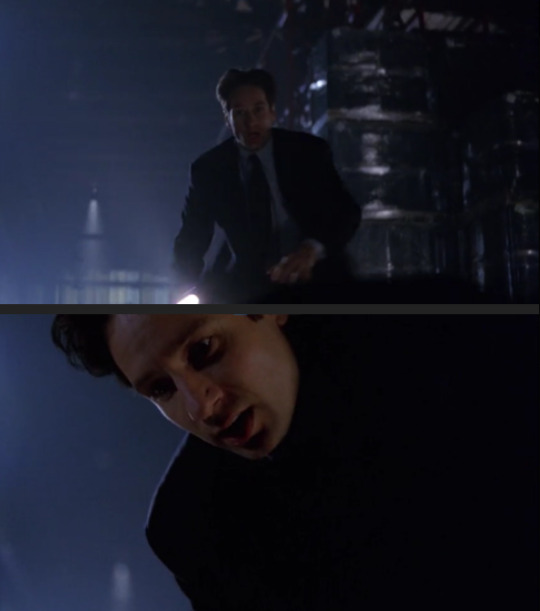
Mulder attempts to feel a pulse. There is none. Scully is dead.
His grief overwhelms him-- an aggravated and more violent (if shorter) version of his sorrow in Redux II-- scrabbling at her scalp and shoulders, silently screaming into her face, before turning away so as not to vomit.

He mentally starts to drift;
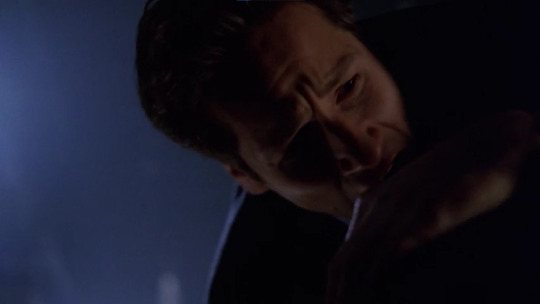
but denial-- denial, denial, denial-- holds sway as he pops his head back up, reenergized,

vainly feeling for a pulse once again, eyes desperately and obsessively focused on his partner.

There is no hope.
Mulder is now losing all control, probably gearing up to an epic meltdown of Biblical proportions-- heavy breathing, desperate eyes, nothing to grasp at or solve or hold onto--

when he hears a noise. A reprieve. A focus. An enemy.
Furious, he snatches a gun and levels it at Linda Bowman, spitting in his fury

...but doesn't fire.
And allows "Bowman" to talk him down.

And further, when "Linda" fires, Mulder flinches, puts his gun up as he dissociates (looks down to his mid-left)-- freezes, if you will-- and doesn't fight back, expecting to die.

This is Mulder's Trauma Responses in full: Freeze-Fight.
He will also begin to repeat this cycle in Milagro (if shorter-- because Scully pops up, alive, sooner.)
Why Mulder Is Primarily a Freeze Type
I'm going to include this entire segment from Pete Walker's Complex CPTSD: From Surviving to Thriving (see notes at the bottom for more info) because it's such a powerful piece of Mulder-psyche that it should stand on its own:
"A Freeze Response is triggered when a person, realizing resistance is futile, gives up, numbs out into dissociation, and/or collapses, as if accepting the inevitability of being hurt.... The Freeze Response, also known as the Camouflage Response, also triggers a survivor into hiding, isolating, and avoiding human contact.
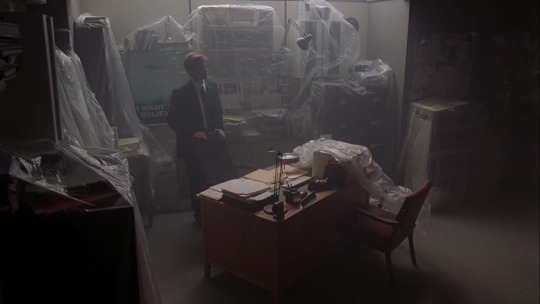
The Freeze Type can be so frozen in the retreat mode that is seems as if their "Starter" button is stuck in the "off" position.

Off all the four Fs, Freeze Types seem to have the deepest and conscious belief that 'people' and 'danger' are synonymous.

While all 4 F Types commonly suffer from social anxiety as well, Freeze Types typically take a great deal more refuge in solitude.
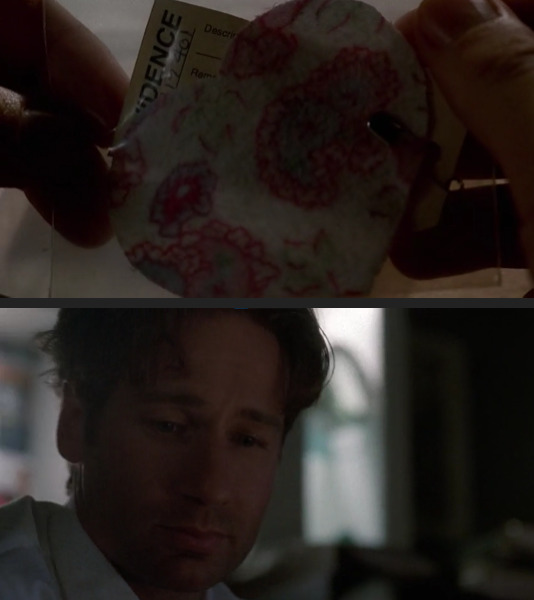


Some Freeze Types completely give up on relating to others and become extremely isolated. Outside of fantasy, many also give up entirely on the possibility of love."

These Types have learned from a young age that fighting back will only get you punished and that fleeing will only get you reprimanded; so, they collapse inwardly instead. Dissociation becomes the name of the game, coasting through life without being attached to it, accepting its blows and distracting themselves from reality with either fantasy or the pursuit of a fantastical idea they want to achieve.
Frank Spotnitz said it best when he reflected on Mulder's character growth and seeking 'The Truth': ""You can't get the truth. You can't. There's a larger truth, though: that you can't harness the forces of the cosmos, but you may find somebody else. You may find another human being. That may be kind of corny and all of that, but that's really it: Love is the only truth we can hope to know, as human beings. That's what Mulder and Scully found after nine years. And that's a lot."
But what about those moments when Mulder runs at danger, demanding answers and yelling down the sky?
**Edit: This is the section i had to refurbish based on proper research.**
Secondary Trauma Responses develop when circumstances are so extreme that a person's initial trauma response is not removing them from danger fast enough; and they then develop a second polar opposite response in the hopes that this will help. More often than not, it simply becomes a ping-pong whiplash between one extreme to the other. The four Hybrids are Fight-Fawn, Fight-Freeze, and Flight-Freeze. In Mulder's case, if he stays frozen for too long he will very quickly become very dead; thus, Mulder developed a secondary response: Flight.
Freeze-Flight (or Flight-Freeze-- potato, potatoh) Types

Below is an excerpt from Pete Walker, but it's so completely Mulder that I have nothing else to add:
"The Flight-Freeze Type is the least relational, most schizoid hybrid. He prefers the safety of "do it yourself" isolationism. The Fight-Fleeze Type avoids potential relationship traumatization with an obsessive-compulsive dissociative two-step. Step One is working to complete exhaustion. Step Two is collapsing into extreme vegging out and waiting until his energy reaccumulates enough to relaunch into Step One. The price for this time of no-longer-necessary safety is a severely narrowed existence."
(**Note for the below paragraph: the author is not talking about alpha/beta in the current, dilapidated vernacular. Think of it as an academic term describing more aggressive or assertive behavior as compared to more passive or dismissive behavior.)
"The Flight-Freeze cul-de-sac is more common among men, especially those traumatized for being vulnerable in childhood. This then drives them to seek safety in isolation, or "intimacy lite" relationships. Some non-alpha type male survivors combine their flight-freeze defenses to become stereotypical technology nerds. Telecommuting is, of course, their preferred modes.
Flight-Freeze Types are the computer addicts who focus on work long periods of time and then drift off dissociatively into computer games, substance abuse, or sleep binging. FF Types are prone to becoming porn addicts: when in Flight mode, they obsessively surf the net for phantom partners and engage in compulsive masturbation. When in Freeze mode, they drift off into Right-Brain sexual fantasy world if pornography is unavailable. Moreover, if they are an intimacy-light relationship, they typically engage more in with their idealized fantasy partners than with their actual partner during real-time sexual interactions."
An interesting note: these types are often misdiagnosed with Aspergers Syndrome, which explains why some fans theorize that an Oxford graduate-FBI field agent might be on the spectrum (Mulder isn't: it's a symptom of him coping very, VERY badly.)
Mulder's Freeze-Flight response kicked in sometime after his sister's abduction, since his primary Freeze response "prevented" him from saving her (even if he couldn't do anything to help.)
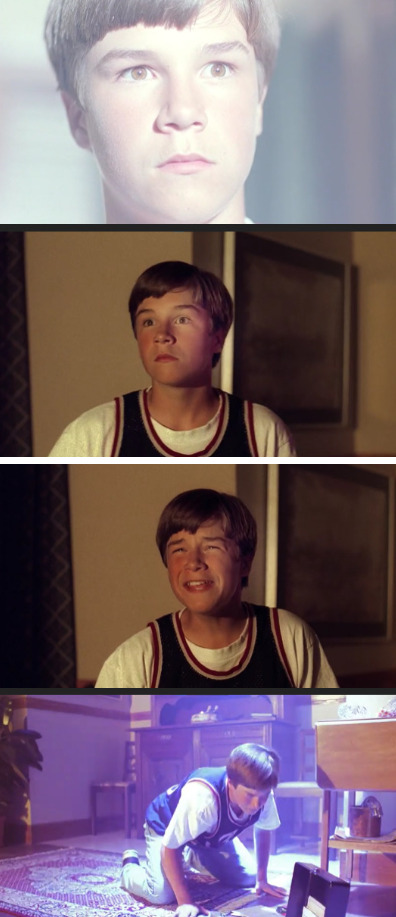
Since then, Mulder has buried all trauma or deep emotion in the bowels of his work in the basement, printing them out as X-Files to brand his work as his life.
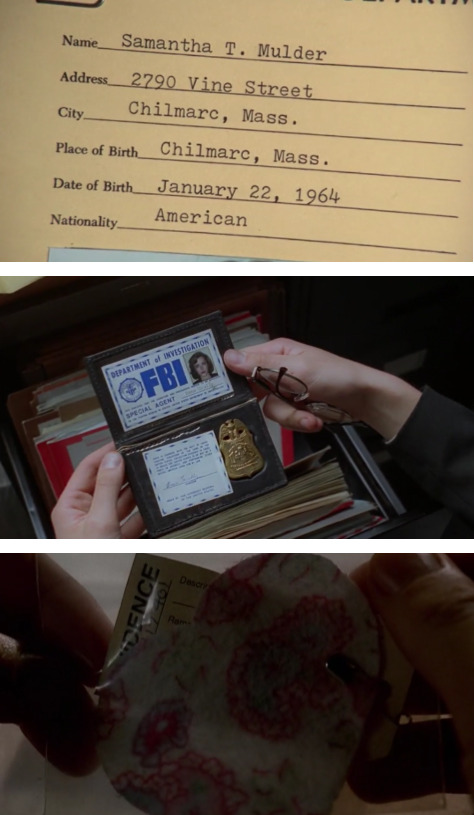
For all of Mulder's talk about disliking others for dismissing something that cannot be explained, labeled, or categorized, when he can't do it himself, he goes berserk: first freezing, horrified, before he launches with righteous fury into his work, demanding answers and running himself ragged.
A potent demonstration of Mulder's yo-yo-ing Freeze-Flight Response is the Russian Roulette showdown in Pusher: Mulder more readily accepts his own death than Scully, terrified but determinedly compliant... until she becomes the next target of Modell's mind games.

It's a pattern that has already been established since her abduction, and which repeats for her cancer (and every perilous moment after and in-between.)


An important
There are countless examples where Mulder disconnects from reality in the face of great grief, ala his father's death, CSM and Diana Fowley's oily plan in One Son, and-- especially-- his mother's suicide.
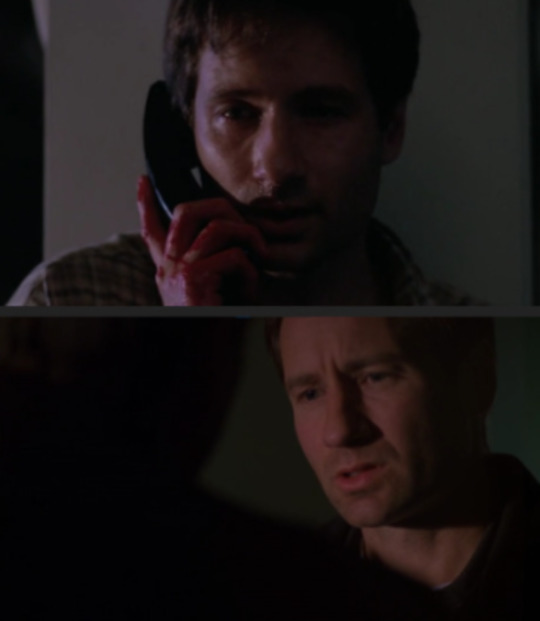
In all these instances, Mulder immediately ran into work mode, trying move the world by force and come up with an explanation-- any-- to make everything right. When he is forced to sit and deal with tragic loss, his Flight peters out, leading him back to square one: an unhealthy Freeze Response.

Luckily for him, Scully is a stable, reliable support; and coaxes him into properly grieving by not sugarcoating the Truth, thereby helping him turn into healthier coping mechanisms (if he wants to use them-- he doesn't in Paper Hearts, but he does in Sein und Zeit. Baby steps.)
In short: Mulder is a Freeze-then-Flight man.
Why Mulder Isn't a Fight, Flight, or Fawn Type

To make quick work of this, I'll rely mainly on Pete Walker quotes again and add my commentary after his statements:
"A Fight [Trauma] Response is triggered when a person suddenly responds aggressively to something threatening.... Fight Types are unconsciously driven by the belief that power and control can create safety, assuage abandonment, and secure love." Extreme Fight Types often become bullies or narcissists to their loved ones as well as their enemies if left unchecked. They are demanding, demeaning, and punishing, equating strength as exerted power over someone weaker. They usually grew up in homes where they had to fight back against physical abuse or protect others from it. This translates to a bitter outlook on the world, always suspicioning the motives of others in cruel or judgmental ways.
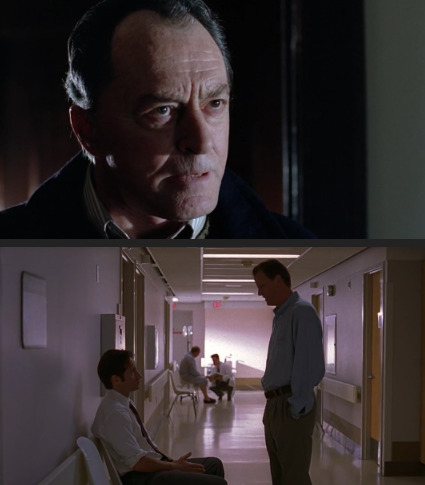
(Note: Not much of the above is directly related to Bill Scully-- or Bill Mulder, even, see my previous post about him here-- but his natural bent is Fight above the other 3 F Types. Doesn't mean he's a bully or a narcissist; just that those would be his extremes.)
As we have seen through the entire series, Mulder as an atypical American masculine archetype: he does not resort to violence, preferring to save victims and even villains, willing to give everyone a second chance (and, by extension, giving backstabbers a clear target for their next strike.) The only time he has exerted violence over another was as a last possible extreme to stop a threat (shooting Modell, shooting the Peacock brothers, shooting Schnauz, shooting Roche, etc.)
Back to Walker:
"A Flight Response is triggered when a person responds to a perceived threat by fleeing; or, symbolically, by launching into hyperactivity. .... Extreme Flight Types are like machines with a switch stuck in the 'on' position. They are obsessively and compulsively driven by the unconscious belief that perfection will make them safe and loveable. They rush to achieve. They rush as much in thought in action, compulsion."
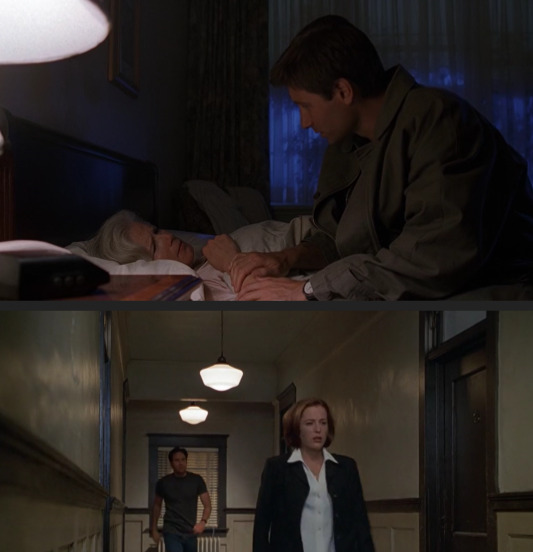
I will be talking about this response a little bit more in a follow-up post; but the core with this character is their ability to distract themselves from their problems into oblivion. Mulder's pains and sorrows and traumas are a constant of his life, eating away at his heart and shoving themselves in his face every day. The difference between his obsessive work ethic and a Flight Type's work ethic is the motivator: he is dabbling in his fantasy, building empires from ideas and discovering new kingdoms with every possibility; while Flight Types have ceased to function at all, robotically going from task to task until they overload or shut down.
And, lastly, back to Walker for the Fawn Trauma Response:
"Fawn Response is triggered when a person responds to threat by trying to be pleasing or helpful in order to appease and forestall an attacker.... Fawn types seek safety by merging with the wishes, needs, and demands of others. They act as if they believe that the price of admission to any relationship is the forfeiture of all their needs, rights, preferences, and boundaries. The disenfranchisement of the Fawn Type begins in childhood... learns early that a modicum of safety and attachment can be gained by becoming the helpful and compliant servant of... exploitive parents." (As an aside, this Type is also formed from having at least one narcissistic parent.)

While Mulder is often used by those around him, he never loses the core of who he is to their abuse: when Phoebe comes knocking, he may set aside the case to (try to) get some hotel action; but he's still self-aware of his and her actions, disentangled enough to self-deprecatingly (and knowingly) smirk when he catches her red-handed with another man. When his father or mother weave in and out of his life with their soft or outspoken demands, he doesn't bend from the Truth, risking his relationships continually for It. He is willing to tell Scully to her face she is lying to him; and he is willing to sacrifice what new closeness they've achieved if he believes she's being purposefully blind or obtuse. Mulder, while reliant on Scully as his human credential, is not co-dependent on her: he can stand on his own two feet, even if she were to walk out of his life. The wounds would go deep; but he would dissociate from life (like he had in Little Green Men) not erode away completely.
(As an aside, that's why probably why Mulder would have committed suicide in Gethsemane but not during the Break Up Years TM. Post IWTB Scully, while she had walked away from their life together, was still a part of his reality; whereas, S4 Scully would have been dead, deceased, gone from existence... and Mulder could never escape that, no matter how much he dissociated from it.)
How Mulder Can Use His Freeze Response Healthy
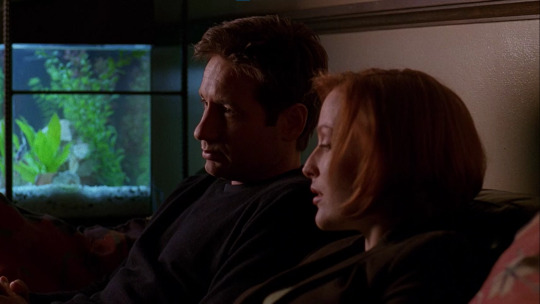
In a nutshell, a person should work through their traumas so they can pick among the 4 Trauma Responses for the healthiest outcome in each situation: Fight for healthy boundaries, Flight for healthy retreat and perseverance, Freeze for healthy awareness and distanced assessment, and Fawn for healthy assertive listening and peacemaking. Unhealthy childhoods create fixations on one of these four; and it takes a while to learn the patterns and triggers in one's life and how to manage them.
For Mulder, he grew exponentially through the years, becoming less detached and more engaged with "life on this planet" (growing from a sarcastic S1 recluse to a more emotionally honest person in S2 to a more openly supportive person in S3 to a transformed heart-on-his-sleeve man in S4-5 to someone who can find joy in S6 and peace in S7 and recreation in S8. Is there canon after that?) So, as it stands, he's doing just fine. Because if one truly searches for the Truth it might not be aliens: it might just be a whole, happy life and how to enjoy it.
And there you have it, folks!
Scully will get her own follow up, soonish (though if you don't want to wait that long, she's a pretty obvious *spoiler* Flight Type. No one's really surprised because of what happened in Fight the Future.)
Thanks for reading~
Enjoy!
*Note*: There are four main trauma Responses: Fight, Flight, Freeze, and Fawn (taken from the book Complex CPTSD: From Surviving to Thriving by Pete Walker-- see Disclaimers section below for info.) In short: Fight Types responds to stress by physical intimidation or verbal bullying; Flight Types run as far as they can from danger or distract themselves from it as much as possible; Freeze Types disassociate, seeing fight and flight as futile and becoming numb to life; Fawn Types try to win favor from their oppressor, leaning co-dependently on others.
**Note**: Most of the information was obtained from Complex PTSD: From Surviving to Thriving by Pete Walker, a private counselor and lecturer for thirty-five years. As a victim of CPTSD himself, he made a study of its victims and helped craft a system for CPTSD recoverees to understand themselves and progressively heal. (Highly recommend his book-- excellent.)
***Note***: I will ghost edit later. Brb.
#txf#Trauma Responses: Fight Flight Freeze Fawn#4 Fs#Mulder#x-files#xf meta#meta#analysis#xfiles#the x files#Fight#Flight#Freeze#Fawn#Pete Walker#Updated#Freeze-Flight#CPTSD#Complex PTSD: From Surviving to Thriving
60 notes
·
View notes
Text
ok are there any other good books out there abt cptsd recovery that arent written by pete walker
#personal#some of the advice on healing is useful but he has abominable things to say abt ppl w/cluster b disorders#and i dont like his attempt to classify personality types of people according to their fight/flight/fawn/freeze response#bc i feel like what response i have to perceived trauma is highly dependent on context and not static#also i wish hed acknowledge that cptsd can come from other sources than our parents#its a solid 6/10 book for me
3 notes
·
View notes
Text
Incarnation
Is the Devil incarnate in me?
Is this urgency to Die the Devil working in my mind,
or is it God's answer to the pain
I’ve tried so long not to claim?
Is the Devil incarnate in me?
perhaps this affliction
is the deep-seeded conviction
that nothing can unremember
unless I unremember me.
Is the Devil incarnate inside?
Has he evicted God from the caverns of my mind?
warped my hopes into ashes
let a plague run rampant
till I’m left with nothing and no options
except to kill the hurt with fire.
But if I disintegrate the pain
will I crumble under the shame?
of asking
how?
And asking
why?
did I ever end up this insane?
Is there a light in this Darkness
or has he made in me his home?
how can I demolish the Devil
without also taking my own?
Can a child of God be used as a pawn
in this war I'm not sure can even be won?
is the Devil incarnate in me?
do I live unalive
or try to surmise
how to make what’s done be Undone
and take leave?
have I fostered this Insanity?
welcomed the disease with open arms?
after one too many breakdowns
it's hard to prove the Devil wrong.
"choose happy,"
"cheer up,"
"you can pray this away,"
(but will God even answer after how far I've strayed?)
the pastors say "yes"
and the priests say "confess"
I ask what Guilt to divulge
when the done that's been done
was done when they did it to me?
is He truly incarnate inside?
people say I used to have beautiful eyes.
Now they're vast void and broken,
like the Devil, they've spoken.
Do I have what it takes to survive?
Does this Devil know what he's done?
created in me this pull that's impossible to shun?
breathed Death into spaces
I used to hold vacant
hoping only for God and his son.
But what Holiness would encroach
into the wasted space beyond reproach?
What God would even try
in me to find
a single spot that’s not ticking time
expectant to die?
why would God seek a way
when I'm unwilling to pay?
Releasing the Devil, I fear
means staying alive’s a lot less clear
He’s scary, it’s true.
I know that. It’s true.
But what’s even more frightening is imagining
life wholly new.
See I’ve lived for years wanting only to die
Have these emphatic thoughts all along been Devil’s lies?
After years of our waltz
Of the Him pointing out faults
His taunts ceased to sting
And instead transformed into an Offering.
Because if I believe him first,
Then no one else could say worse.
And that’s a Devil that’s comfortable for me.
But why should I stay?
So goes the refrain
To hear more from a God who proudly claims
Of floods
And famines
And wretched father-son-games?
No. I said no!
I don’t want to know
Don’t want to sow
The seeds of Sacred Silence, and so
Keep out, Holy One!
I seek no comfort in your show.
Your platitudes and play
Are not enough to make me stay.
For I’d rather die with the Devil
Than lay false claim in your name.
#mental illness#recovery#suicid3#devil#heaven#hell#christianity#faith#mental health#edrecovery#timberline knolls#ptsd#church trauma#church#holy one#sierra tucson#eating disorder#eating disorder recovery#trauma#trauma recovery#emotional abuse#sexua1 abuse#abuse#trauma response#fight#flight#freeze#fawn#god#Christian
2 notes
·
View notes
Text
youtube
We've heard of fight, flight, freeze, but what about the 4th fawn or fawning? In this video I'll talk through what fawning is, what it looks like, 7 signs fawning is hurting your relationships and then how to best support ourselves if we fawn or struggle with fawning. Fawning is a type of stress response that may be common if someone is experiencing any type of PTSD that may come from a various degree of childhood or adult situations like emotional neglect. And there are many signs or symptoms of PTSD and it may not look exactly like fawning; however, fight, flight, freeze and fawn are common stress responses if someone has experienced trauma situations that are left not dealt with. Let's dive into the 7 signs fawning is hurting your relationships and how to heal from this. Do you fawn? What has your experience been like?
#fawn response#fawning#stress response#fight flight freeze fawn#mental health#kati morton#therapy#psychology#mental illness#support#recovery#help#anxiety#overwhelmed#childhood trauma#trauma recovery#trauma#ptsd#Youtube
5 notes
·
View notes
Text
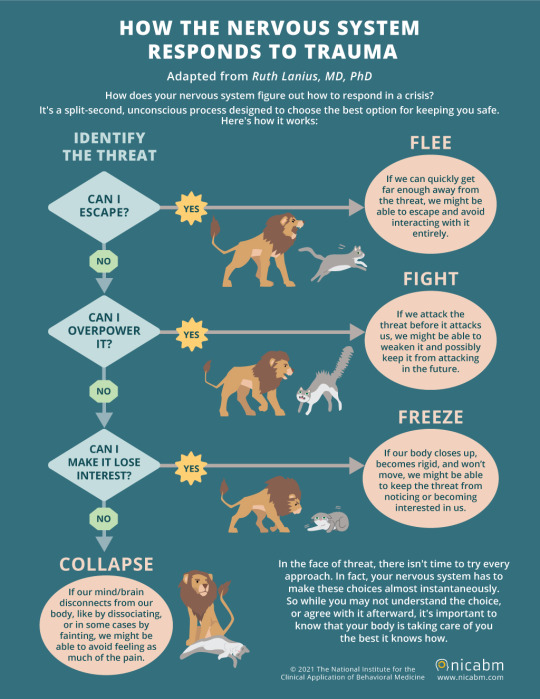
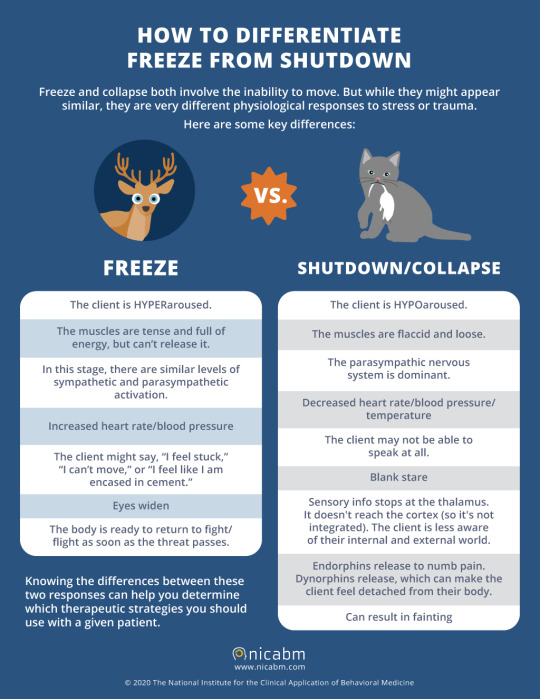

15 notes
·
View notes
Text
Iwtv s2 ep 2 spoilers / mini meta
Since I haven't seen anyone mention it yet, the scene where louis was discussing Lestats will and testament with Daniel, he seems to begin having an anxiety attack, that's why he lashes out at Daniel.
I thought it was pretty obvious, but also I suffer with anxiety and have aggressive responses, so maybe not everyone knows this.
#im guessing louis has pretty severe ptsd and the show has made that clear#so when he starts pulling up bad memories of daniels he's doing a 'fight' response#there are about four responses people have to trauma 'flight fight freeze and fawn'#daniel was triggering him and so louis responded trying to emotional cut him. ive been in his shoes before. not the exact same situation but#saying something to hurt someone because they triggered you#iwtv#iwtv season 2#louis de pointe du lac
6 notes
·
View notes
Text
Prompt Idea: Fight or Flight Responses:
One shots based on the fight or flight responses:
Fight: character fights back or lashes out in response to an attack or trauma and it’s aftermath.
Flight: character avoids situations reminiscent of trauma or refuses to acknowledge or process it, fleeing in response to conflict.
Freeze: character freezes up when confronted, shutting down at the first sign of trouble, unable to move or act. Similar reactions occur when trauma resurfaces.
Fawn: much like a fawn chased by a predator, the character knows/feels they are doomed and gives up entirely, at the mercy of their assailant and/or trauma.
Talked about these responses with my therapist today and had to turn it into whump lol. Feel like it has some potential for stories and one shots and stuff. Tag me if you want if you use this format but you don’t have to. Would just love to see what people come up with!
#whump prompt#fanfiction prompt#prompts#prompt#writing prompts#whump writing#whump community#whump tropes#whumpblr#whumper#whumpee#fight or flight#fight#flight#freeze#fawn#trauma response#fear#angsty#angst prompts#angsty prompts#fic prompts
32 notes
·
View notes